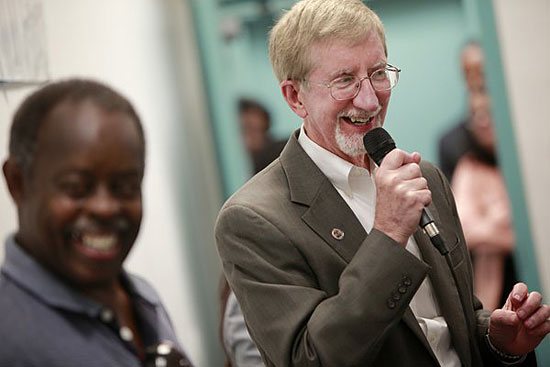Reinventing DCFS
August 8, 2013

Philip Browning, at a community meeting, is leading the charge to transform DCFS from within. Photo/L.A. Times
Despite the highly-publicized creation of a blue-ribbon commission to investigate potential flaws in Los Angeles County’s child protection system, the Department of Children and Family Services already is in the midst of a sweeping transformation aimed at boosting the beleaguered agency’s effectiveness and accountability.
The breadth of the year-long effort was disclosed publicly for the first time this week by DCFS Director Philip Browning during a presentation before the Board of Supervisors. Appointed less than a year ago by the board, Browning has spearheaded the department’s first strategic plan in a decade—“an adventure,” he calls it—revamping everything from the training and deployment of social workers to the creation of a database identifying children with the greatest levels of instability in their lives.
And, as he did while previously heading the county’s Department of Public Social Services, Browning has brought a statistical sensibility to virtually all facets of DCFS operations, holding managers accountable for achieving quantifiable measures of effectiveness. At the same time, he’s worked closely with, and sometimes bucked, the department’s union to keep more experienced social workers on the front-lines, where they can better protect children in potentially abusive homes.
In recent weeks, concerns have been expressed by some officials, including Supervisor Zev Yaroslavsky, that the board-appointed Blue Ribbon Commission on Child Protection might slow the department’s momentum by making burdensome demands on the agency during the panel’s six-month examination. But the commission’s newly-installed chairman, former DCFS Director David Sanders, insisted in an interview last week that he’s sensitive to the potential for distraction and expects the panel’s work to focus more broadly on the network of agencies entrusted with protecting the county’s children.
In fact, the non-profit Casey Family Programs, where Sanders is now a top executive, is helping DCFS streamline a 6,000-page policy manual that staffers rightly complained was impossible to penetrate, Browning said during his presentation before the board this week, noting that the rewrite was one of numerous “game changers” underway. Among the others:
- Creating a radically different training program for incoming social workers. The curriculum at six local universities that channel social workers to the county is being standardized, revamped and expanded from 8 weeks to 52, with an emphasis on “much more critical thinking and much more real life experience,” Browning said. A key element is being created at USC, where a stage set depicting a roach-infested house in a gang-dominated neighborhood is under construction. Social workers in training will interact with a cast of role-playing adults and children in simulated real life situations, as professors and other students observe the action from behind a one-way mirror.
- Devising an unprecedented data-driven model for customizing social worker caseloads. Previously, caseloads remained largely uniform throughout the department’s 18 field offices. But under Browning’s direction, the agency has created a statistical formula that takes into account the prevalence of certain risk factors among children served by each office. Under the “caseload equity” initiative, social workers in offices with the highest risk scores will be given fewer cases, allowing them to devote more attention to children facing the greatest dangers.
- Preventing emergency response staffers from transferring to new posts after a year. Browning, to the consternation of some of the agency’s unionized social workers, has imposed a freeze on the longtime practice of front-line workers transfering after a single year. These jobs are among the agency’s most demanding and stressful, involving life-and-death decisions about whether to leave children with their families or remove them. Although the union contract allows workers to request such transfers, Browning says he made a “management decision” to block the practice because children were being ill-served by the chronic turnover and brain drain. He’s now pushing for a three-year minimum assignment.
- Developing and implementing a “high risk database” to identify children who need more intensive intervention. Using data mining techniques, the department created an algorithm, believed to be the first of its kind anywhere, that weighted various factors—including how often a child runs away, has a psychiatric hospitalization or moves to different homes—to find those among the 35,000 children in its care who are the most unstable and at risk of aging out of the system into homelessness, joblessness and despair. They are then targeted for an array of tailored treatment services. Browning said 100 high-risk children already have been provided more permanency and stability with a family member, a foster family or a group home.
During his presentation, Browning acknowledged that, while progress has been made, it’s only a start. And he gave the board an example from his world to consider. From their desktop computers, he told the supervisors, “you can see any hotel in the world. You can see what the pool looks like. You can make a reservation.”
But when it comes to using a search engine to find an available home for a foster child, he said, “we can’t do that well in Los Angeles County. We can’t tell if there’s a vacancy for a 2-year-old. That’s something we’ve been working on…and I think we’re going to get there.”
Posted 8/8/13












 405 bridge work causes a stink
405 bridge work causes a stink

